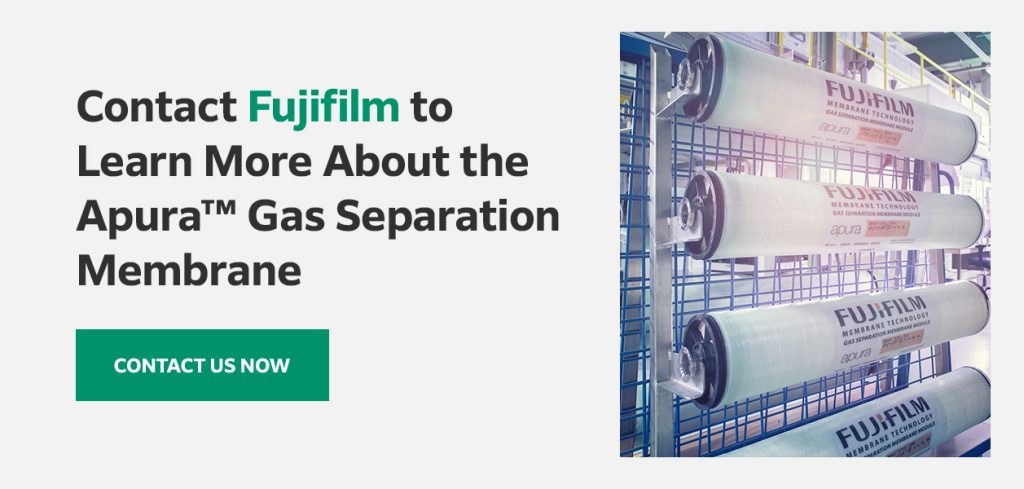
Jump to:
- What Is EOR?
- How Does EOR Work?
- Types of EOR
- How Gas Separation Membranes Can Help
- The FUJIFILM Apura™ Gas Separation Membrane
Throughout history, innovation has helped to streamline operations and increase efficiency. The oil exploration and refinery field is no exception. One of these innovative techniques is enhanced oil recovery (EOR), which has revolutionized the oil and gas industry, allowing operators to increase the amount of oil recovery exponentially.
What Is EOR?
Oil production occurs in three separate stages — the primary, secondary and tertiary phases. The tertiary phase, also known as enhanced oil recovery (EOR), involves the extraction of oil that has not already been retrieved through the first two stages. In other words, the EOR helps recover more oil after the primary and secondary techniques have reached their limits.
The primary and secondary oil recovery phases rely on the pressure differential between the underground and surface wells. The EOR alters the chemical composition of the oil itself to simplify extraction. Although the technique is more expensive, it can increase oil production by a significant amount.
How Does EOR Work?
EOR techniques can be more complex and expensive than other methods. As a result, they are typically used as a last step after the primary and secondary recovery approaches reach their full potential but leave more oil to be extracted. In some instances, oil is left in the reservoir due to cost.
The primary recovery approach uses natural pressure in the reservoir to recover oil. At the secondary recovery stage, pressure in the reservoir is maintained by injecting gas or water (H2O) into the formation’s gas cap. Typically, these two phases leave a large portion of the oil in the ground, making EOR the last alternative.
The EOR process artificially injects gas, steam or chemicals into the reservoir to change the oil’s physical properties. The oil becomes less viscous and increases its ability to flow.

Types of EOR
There are three enhanced oil recovery techniques.
1. Gas Injection
The gas injection or CO2 EOR method uses carbon dioxide (CO2) or nitrogen (N2) gas for the miscible displacement of crude. As the gas dissolves in the oil, it becomes less dense, improving mobility. According to the U.S. Department of Energy, nearly 60% of the EOR production in the country adopts this technique.
CO2 pumps into the formation through injection wells. This process causes the gas to form a miscible zone that mops up stranded oil and pushes it toward the production casing of the target well at high downhole pressures. Gas injection is usually alternated with H2O injection using an H2O injection pump system to enhance sweep efficiency.
2. Steam Injection
The thermal EOR process introduces heat into the reservoir to reduce the oil’s viscosity. In other words, H2O vapor is injected into the reservoir at high pressure and temperature to mop up stranded oil when there is a decline in the formation pressure. This method thins the oil and improves its ability to flow.
The operators drill wells to stimulate the oil. Then, they inject the steam into the formation through the injection well. When the steam comes into contact with the oil, it reduces viscosity and increases the kinetic energy. As a result, the oil becomes more mobile toward the production casing.
The thermal injection technique accounts for over 40% of EOR production in the U.S., primarily in California, and is especially useful for recovery in heavy oil reservoirs.
3. Chemical Injection
The chemical EOR process involves the injection of long-chain molecules — polymers — into a well through a chemical injection skid to increase the efficacy of waterfloods. Operators may also use detergent-like surfactants to reduce the surface tension that usually prevents oil droplets from moving through the reservoir.
The polymers used in the EOR process can be micellar or alkaline substances. These substances enhance sweep efficiency by reducing the interfacial tension between the H2O in the reservoir and the hydrocarbon molecules. The chemical injection approach accounts for about 1% of the EOR production in the U.S.
These EOR approaches improve oil extraction significantly. However, these processes can negatively impact the environment and alter the oil’s composition. Often, tertiary oil production is also one of the most costly stages.
How Gas Separation Membranes Can Help
Natural gas usually contains contaminants like CO2, hydrogen sulfide (H2S) and H2O. These substances can impact the process performance and damage equipment. Implementing gas sweetening enables operators to remove H2S and carbon dioxide from natural gas.
The gas separation membrane technology separates gases by feeding a pressurized gas into a membrane module. The process purifies or divides single or multiple gas components. The membrane is usually a nonporous layer or polymer, which enables the execution of selective gas separation, tuning the permeability of selected species. Polymeric membranes have excellent CO2 removal capacity. They also have exceptional permeability and high selectivity.
The FUJIFILM Apura™ Gas Separation Membrane
The Apura™ natural gas purification solution uses pressure from a spiral wound membrane to remove CO2, H2S and H2O. This technology features effective and cost-efficient gas-sweetening components and is an ideal solution for EOR to concentrate CO2, a technique already used on several sites. Combining Apura™ with Fujifilm’s high-quality multilayer composite membrane technology gives you a robust, practical module against H2O and aromatics.
Compared to the amine gas treatment process, Apura™ has a simple design, making installation fast and straightforward. Since the gas separation membrane has fewer moving parts, it also cuts maintenance costs. Ultimately, this technology positively impacts your company’s bottom line with reduced day-to-day operating expenditures (OPEX) and long-term capital expenditures (CAPEX).
Fujifilm Apura™ also has some vital environmental benefits. The solutions are safer than the amine treatment process since they function without chemicals and solvents. This benefit allows you to comply with the increasingly stringent environmental regulations. Finally, Apura™ has lower energy consumption, allowing your company to save utility costs while reducing CO2 emissions.

Contact Fujifilm to Learn More About the Apura™ Gas Separation Membrane
Beyond offering more cost-effective and efficient solutions than amine treatment, Fujifilm supports your oil production processes with industry-leading technical support and expertise. Our purpose-built products improve performance, maintain productivity and lessen environmental impacts to bring your gas treatment operations into the next generation of the industry.
Fujifilm Apura™ gas separation membrane enables you to purify the gas components and remove CO2 and H2S. It’s simple to implement, reduces costs and saves the environment. If you want to learn how to replace or enter the gas separation membrane field, contact us now!













